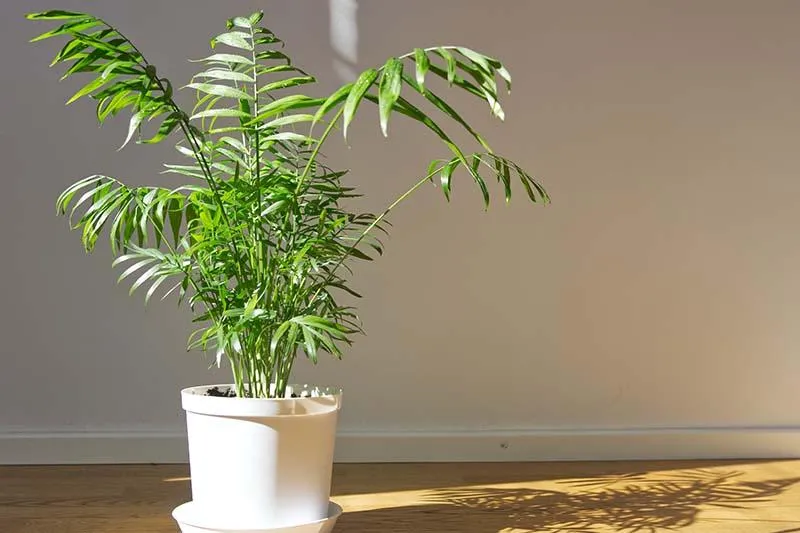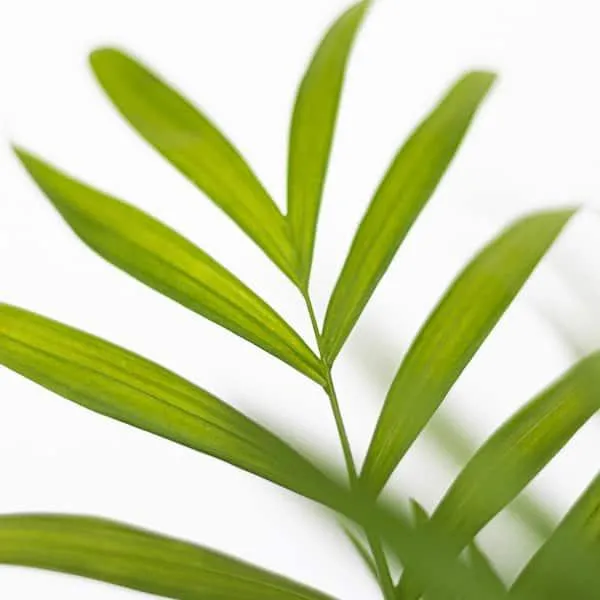Is the Parlour Palm (Chamaedorea elegans) Toxic to Dogs?
The parlour palm, also known by its botanical name Chamaedorea elegans, is a popular indoor houseplant appreciated for its small stature and graceful feather-like fronds. However, many dog owners wonder if this plant is safe to have around their furry friends. In this article, I will address all aspects of this question to help you decide if the parlour palm is a good indoor plant choice for homes with dogs.
Toxicity of Parlour Palm to Dogs
According to the Animal Poison Control Center and the American Society for the Prevention of Cruelty to Animals (ASPCA), the parlour palm contains calcium oxalate crystals that can cause oral irritation and gastrointestinal upset if ingested by dogs. While it is considered “moderately toxic”, toxicity usually only occurs if a large amount of the plant material is eaten.
From my experience as a veterinary nurse, most dogs will avoid eating houseplants as their taste and texture is generally unappealing. However, puppies or curious dogs may sample plants as part of their natural urge to chew and explore. So while one or two bites of parlour palm fronds are unlikely to cause harm, eating a large quantity could potentially lead to vomiting, diarrhea or mouth irritation.
Signs of Parlour Palm Toxicity in Dogs
If your dog does consume a significant amount of the parlour palm, watch out for the following symptoms of toxicity:
- Excessive drooling
- Vomiting
- Diarrhea
- Abdominal pain
- Loss of appetite
Symptoms usually appear within 4-6 hours of ingestion and last for 1-2 days as the plant material passes through the digestive system. More serious cases could potentially cause kidney damage if large amounts of calcium oxalate crystals are consumed.

First Aid for Dogs that Eat Parlour Palm
If you see your dog chewing on or swallowing parts of the parlour palm, it’s best to induce vomiting right away if possible. This allows removal of any plant material still in the stomach before absorption.
You can try having your dog drink a solution of 3% hydrogen peroxide at a dose of 1 mL per 5 pounds body weight. This may induce vomiting within 5-10 minutes. Be sure to monitor your dog closely during and after vomiting. Never attempt to make an animal vomit without veterinary guidance.
Take your dog to the vet for evaluation if symptoms like vomiting or diarrhea persist for more than 24 hours or your pet seems lethargic. The vet may recommend activated charcoal or other GI protectants to absorb any remaining plant toxins.
Can Dogs be Around Parlour Palms?
Whether the parlour palm is suitable for homes with dogs really depends on the individual dog. In general, well-trained adult dogs that don’t chew on objects or sample plants are unlikely to ingest enough palm material to cause issues.
However, there are some safety precautions I would recommend if you do want to keep a parlour palm indoors with dogs:

- Place the palm up high, like on a tall shelf or hanging plant, to prevent chewing/eating.
- Consider keeping it behind a baby gate or in a separate “off limits” room when unsupervised.
- Be extra vigilant with curious or destructive puppies/dogs until they are trained not to chew plants.
While exposure to small amounts of parlour palm is possibly okay for most dogs, I’d avoidplacing it where pups can easily access it. It may also be best to find a non-toxic alternative if you have a dog with a history of plant chewing.
Safer Alternatives to Parlour Palm with Dogs
If you want an air-filtering houseplant but are wary of toxicity risks with dogs, here are some gorgeous options that are completely non-toxic:
- Spider plant (Chlorophytum comosum): Easy to care for, tolerant of low-light. Helps remove benzene and formaldehyde from air.
- English ivy (Hedera helix): Thrives in bright, indirect light. Absorbs air toxins like trichloroethylene and xylene.
- Peace lily (Spathiphyllum): Beautiful white blooms. Reduces levels of benzene, trichloroethylene and formaldehyde.
Any of these lovely non-toxic plants could bring the same visual appeal as the parlour palm without safety worries concerning dogs. So in summary – while a small parlour palm is probably fine in most homes with dogs, safer plant options exist if you have concerns.
Final Thoughts on Parlour Palm Safety
I hope this detailed breakdown has helped address all the potential questions a dog owner may have about the toxicity risk of keeping a parlour palm. From my experience in vet clinics, most well-trained adult dogs safely coexist with moderate-toxicity houseplants like this one.
However, there is always some uncertainty since every puppy/dog’s personality and habits differ. By taking basic precautions to place palms up high or behind gates, monitoring chewing behaviors, and considering safer non-toxic alternatives – owners can feel confident the plant poses minimal risk to their furry friend.

Let me know if any other questions come up! Animal safety is so important, so it’s better to be over-cautious than under when little ones are involved. With care and common sense, parlour palms can definitely be an option for green-thumbed dog parents too.
Chamaedorea elegans (parlor palm) pet safety information
| Characteristic | Details |
|---|---|
| Toxicity | Non-toxic to dogs and cats. No known toxicity issues. |
| Allergenic properties | Unlikely to cause allergic reactions in pets. |
| Physical hazards | May pose choking hazard to very young pets from loose fibers or fallen fronds. Stems can cause minor mouth injuries from chewing. |
| Care requirements | Low light and infrequent watering requirements make it generally pet-safe if untended to by pets. |
| Suitable locations | Can be placed on tables or shelves out of reach of animals. Avoid areas where pets may access and ingest soil or damage plant. |
FAQ
-
Is the chamaedorea elegans plant safe for dogs?
Generally, the chamaedorea elegans plant, also known as the parlor palm, is non-toxic to dogs. However, some dogs may experience mild stomach upset if they eat large amounts of the plant. So it’s best to keep the palm higher up or out of reach if possible.
-
Is the palm tree poisonous to dogs?
While the chamaedorea elegans palm itself isn’t considered poisonous, dogs sometimes try to nibble on it. The palm leaves can act as an irritant to the mouth if chewed or swallowed. So if Fido seems interested in tasting the plant, it’s best to move it somewhere up high. Overall though, this houseplant isn’t seriously harmful if consumed by dogs in small quantities.
-
Will my dog get sick from licking a parlor palm?
It’s unlikely a dog would get truly ill from licking the leaves of a parlor palm, even though the plant’s sap could cause mild tummy trouble in big doses. A little lick here and there is basically OK. However, some dogs obsessively lick houseplants, which isn’t that awesome. To be safe, try giving pup extra attention so they don’t feel the need to sample your greenery!
-
Can the pollen from a parlor palm bother dogs?
While the plant itself poses little risk, it’s possible the pollen from a chamaedorea elegans could potentially trigger allergies in some sensitive dogs. Similar to how certain pet owners deal with pollen allergies, actually. The pollen is unlikely to make a dog seriously sick, just maybe somewhat uncomfortable. So if Fido seems to react after being around the palm, moving it might help.

-
Is it safe keeping a parlor palm as a houseplant with pets?
In general, the parlor palm makes a good non-toxic houseplant choice to have around dogs. Yet to be on the safe side, keep it out of reach since some pups find them appealing to sample. You can also regularly wipe down leaves and check for pollen buildup that could irritate allergic pets. With some minor precautions though, this palm tree should pose no threat to share living spaces with furry friends.
-
What should I do if my dog eats part of a parlor palm?
If Fido decides to nibble on the palm, don’t panic. It’s unlikely the plant would cause serious harm unless he ate a huge amount. Keep an eye out for any tummy problems and contact your vet if he seems distressed. Meanwhile, make the plant unattainable to deter further sampling. In most cases, no treatment would be needed for casual palm eating. But it’s always smart to monitor pets after plants are ingested, just in case.
On the other hand, some pet owners have been keeping parlor palms in their homes for years with no issues concerning their dogs. The plant’s mild toxicity seems to mainly pose a risk if large quantities are swallowed. So in moderation and with common sense precautions, sharing living space with this palm may “kind of” present little risk to most canine companions. Let me know if any other questions come up!
